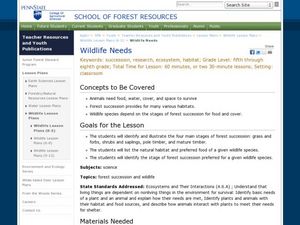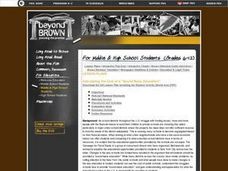Curated OER
Do You Need What I Need?
Student identify the basic human needs. In this life science instructional activity, 3rd graders compare the needs of plants, animals and humans. They apply what they have learned by playing a survival team game.
Curated OER
What We Need
First graders identify basic needs of plants. In this plant growth lesson, 1st graders observe types of plants and review the parts of a plant as well as the development of a seed. Students review related vocabulary and read The...
Curated OER
Citizens For the New Zoo
Third graders complete Internet research to find information about an animal and its basic needs. They design a model of a zoo habitat that would accommodate their animal. They write a letter of recommendation to a Zoo board of directors...
National Wildlife Federation
Massive Migrations: Grades 5-8
Many Arctic species only spent a fraction of their lives in the Arctic region. Scholars research migrating Arctic species to learn more about their habits. They focus on their migration habits including distances, time, and challenges...
Curated OER
Altruism: Meeting Society's Needs
Students study society's needs and altruism within communities. In this altruism lesson, students identify and categorize the basic needs that human beings have and define altruism. Students complete research on altruistic...
Education World
Take Five: Writing a Color-Coded Paragraph
Use a traffic light to model a very basic paragraph plan. The Go, or topic sentence, is written in green and expresses an opinion about the topic. Information that supports the opinion of the Go sentence is written in yellow and the...
Curated OER
Wildlife Needs
Students identify the wildlife needs in a specific setting. In this wildlife needs lesson, students identify and illustrate the four stages of forest succession. Students list the natural habitat and food for a given species. Students...
Curated OER
Basic Paragraph
Students with special needs examine how to write an organized, basic, five-sentence paragraph. Students write a paragraph with a topic sentence, supporting sentences and a concluding sentence. They first practice by viewing and...
Curated OER
Basic Paragraph
Explore basic paragraphs. Young writers compose a topic sentence, supporting sentences, and a concluding sentence. This lesson is intended for use with a SMART Board, a software technology web link is induced.
Curated OER
Needs and Wants
Students examine the difference between psychological needs and wants to control spending.
Curated OER
Dinosaurs
Students are introduced to the various types of dinosaurs and write in their journals about their favorite one. After listening to a story and watching a filmstrip, they color a few pages in their Dinosaur Friends Book. They also examine...
Curated OER
Touch and Abstinence
FLASH has put together another good lesson about touch and abstinence. Humans need human touch, yet many confuse this need for touch, and their desire for sex. Discuss the four types of touch with your health or teen issues class. There...
Curated OER
Calculating the Cost of a "Sound Basic Education"
Students state their opinions about school funding and the use of monetary resources by school districts and use reasons, facts, and examples to support their ideas. They compare sets of data related to school funding and draw...
Curated OER
What Do We Need In Our Environment To Survive?
Young scholars discuss and write about waste management to save the environment. In this environment lesson, students discuss what an alien coming to Earth would notice about the environmental needs of humans for survival. They pretend...
California Polytechnic State University
Australian Geography Unit
At the heart of this resource is a beautifully detailed PowerPoint presentation (provided in PDF form) on the overall physical geography of Australia, basic facts about the country, Aboriginal history, and Australia culture and lifestyle.
Kenan Fellows
Sustainability: Learning for a Lifetime – The Importance of Water
Water is essential for life—and understanding the importance of clean drinking water is essential in understanding sustainability! Show your environmental science class the basics of water testing and treatment through a week-long...
Curated OER
Dolch Sight Word Booklet
First and second graders expand their vocabulary by reading a word recognition booklet. For this English vocabulary lesson, learners utilize a booklet of 220 basic sight words which they read over everyday and are quizzed on the...
Curated OER
How To Find a Site
Fourth graders identify the three basic needs of humans. They identify on a map the best places to live and make a list of items that they can find on a map - streams, river, hills, plains, forests, etc.
Curated OER
The Soil Chain
Fourth graders show the needs of plants met by soil. In this Science lesson, 4th graders detail the components of soil and determine which are living or once living and non-living. Students determine the needs of plant growth that are...
Curated OER
Trading Information
Students create a trading card about a state bordering the Mississippi River. Using traditional and internet research, students generate a list of interesting facts about their chosen state using the five themes of geography. They use...
Curated OER
Nutrition
Students create a video incorporating clay animation and skits. Using their video creation, students explain and explore the five basic food groups, nutrition news, nutrients, benefits and food examples. They maintain a food journal,...
Curated OER
Five Themes of Geography
Students explore the five themes of geography: place, region, interaction, location and movement. They create a Powerpoint presentation with separate slides for each of the themes.
Curated OER
Five Great Reasons to Live on the NC Coast
First graders create ClarisWorks Slide Show on "Five Great Reasons to Live on the NC Coast," incorporating pictures from various sources, use word processing skills to write brief explanation of their reasons, and create individual flap...
Curated OER
Five Parts That Contribute to the Whole
Students listen to and read an online story. Then they use a graphic organizer to learn the basic story elements. They select another online story and create a graphic organizer for its story elements.























